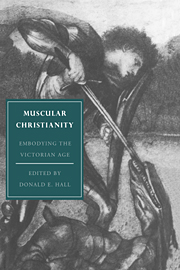Book contents
- Frontmatter
- Contents
- List of contributors
- Acknowledgments
- INTRODUCTION
- PART I FOUNDATIONS OF MUSCULAR CHRISTIANITY
- PART II VARIETIES OF MUSCULAR CHRISTIANITY
- 4 Charles Kingsley's scientific treatment of gender
- 5 Young England: muscular Christianity and the politics of the body in Tom Brown's Schooldays
- 6 Muscular spirituality in George MacDonald's Curdie books
- 7 “Degenerate effeminacy” and the making of a masculine spirituality in the sermons of Ralph Waldo Emerson
- PART III RESPONSES TO MUSCULAR CHRISTIANITY
- Index
4 - Charles Kingsley's scientific treatment of gender
from PART II - VARIETIES OF MUSCULAR CHRISTIANITY
Published online by Cambridge University Press: 05 March 2010
- Frontmatter
- Contents
- List of contributors
- Acknowledgments
- INTRODUCTION
- PART I FOUNDATIONS OF MUSCULAR CHRISTIANITY
- PART II VARIETIES OF MUSCULAR CHRISTIANITY
- 4 Charles Kingsley's scientific treatment of gender
- 5 Young England: muscular Christianity and the politics of the body in Tom Brown's Schooldays
- 6 Muscular spirituality in George MacDonald's Curdie books
- 7 “Degenerate effeminacy” and the making of a masculine spirituality in the sermons of Ralph Waldo Emerson
- PART III RESPONSES TO MUSCULAR CHRISTIANITY
- Index
Summary
Nineteenth-century popular fascination with scientific knowledge and discoveries (Russett 5) amply bears out Thomas Laqueur's contention in Making Sex that empirical discoveries in science often are interpreted only as further support for accepted ideas. Regardless of the factual accuracy of Victorian theories of disease transmission or of heredity, for instance, the theories themselves could influence larger concepts of human society and personality. The “sudden acquisition of much physical knowledge” that Walter Bagehot claimed as one of Victorian England's chief distinctions (quoted in Gay, Education, 52) provided a way to naturalize a wide range of prescriptive notions. As scholars grow increasingly interested in the ways in which ideology subtly structures both “practical” knowledge and the literary texts that draw upon that knowledge, the works of formerly neglected writers such as Charles Kingsley become increasingly accepted as subjects for serious consideration. In his combination of moral earnestness and scientific enthusiasm, his eagerness to find moral significance in natural patterns, Kingsley represents some of the major tendencies in Victorian culture.
The “factual” basis on which Kingsley founded his concern for the maintenance of distinct gender roles was not only scientific, but specifically hygienic. Relying on a model of scientific impartiality and certainty, Kingsley praises the “valuable light” of objective knowledge, and declares that “enough, and more than enough, is known already” to preserve personal health (“Science of Health” 30).
- Type
- Chapter
- Information
- Muscular ChristianityEmbodying the Victorian Age, pp. 91 - 113Publisher: Cambridge University PressPrint publication year: 1994
- 3
- Cited by



